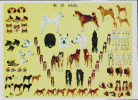
Akita StandardFCI nr 255 b |

Picture of standard in full size |
|
AKITA FCI Standard No. 255. Origin: Japan Utilization: Companion dog Classification F.C.I.: Group 5 (Spitz and primitive dogs) Breef historical summary: Originally Japanese dogs were small to medium in size and no large breeds existed. Since 1603 in the Akita region, Akita Matagis (medium sized bearhunting dogs) were used as fighting dogs. From 1868 Akita Matagis were crossed with Tosas and Mastiffs. Consequently, the size of this breed increased but characteristics associated with Spitz Type were lost. In 1908 dog fighting was prohibited, but this breed was nevertheless preserved and improved as a large Japanese breed. As a result, nine superior examples of this breed were designated as Natural Monuments in 1931. During World War II (1939-1945), it was common to use dogs as a source of fur fot military garments. The police ordered te capture and confistacion of all dogs other than German Shepherd Dogs used for military purposes. Some fanciers tried to circumvent the order by crossbreeding their dogs wit German Shepherd Dogs. When W.W. II ended, Akita had been drastically reduced. In number and existed as three distinct types: 1) Matagi Akitas, 2) fighting Akitas, and 3) Shepherd Akitas. This created a very confusing situation in the breed. During the restoration process of the pure bred after the war, Kongo-go of the Dewa line, which exhibited characteristics of the Mastiff and German Shepherd Dog influence, enjoyed a temporary but tremendous popularity. However, sensible learned fanciers did not approve of this type as a proper Japanese breed, so they made efforts to eliminate the strain of foreign breeds by crossbreeding with Matagi Akitas for the purpose of large sized breed as known today. General appearance: Large sized dog, sturdily built, well balanced and with much substance; secondary sex characteristics strongly marked, with high nobility and dignity in modesty; constitution tough. Important proportions: The ratio of heigh at withers to length of body is 10 :11, but the body is slightly longer in bitches than in dogs. Behavior and temperament: The temperament is composed, faithful, docile and receptive. Head: Cranial region: Facial region: Jaws/Teeth: Teeth strong with scissor bite. Cheeks: Moderately developed. Eyes: Relatively small, thick, triangular in shape due to the rising of the outer eye corner, set moderately apart, dark brown: the darker, the better. Ears: Relatively small, thick, triangular, slightly rounded at tips, set moderately apart, pricked and inclining forward. Neck: Thick and muscular, without dewlap, in balance with head. Body: Limbs: Forequarters: Hindquarters: Coat: Urajiro: whitish coat on the sides of the muzzle, on the cheeks, on the underside of jaw, neck, chest, body and tail and on the inside of the legs. Size: There is a tolerance of 3 cm more and less. Faults: Any departure from the foregoing points should be considered a fault and the seriousness with which the fault should be regarded should be in exact proportion to its degree.
Disqualifying faults:
N.B. : Male animals should have two apparently normal testicles descended into the scrotum. |
|
 |
|